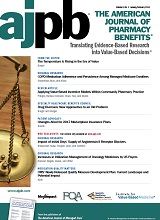Publication
Article
AJPB® Translating Evidence-Based Research Into Value-Based Decisions®
The Temperature Is Rising in the Era of Value
Author(s):
Without the use of comparative effectiveness as a strong part of the care decision-making process, we will never reach the goal of value-based care.
I recently returned from my pilgrimage to San Francisco for the J.P. Morgan 33rd Annual Healthcare Conference.
For those of you that do not have knowledge about this January ritual, let me take a minute to explain: this event brings together approximately 30,000 healthcare stakeholders—including payers, service organizations, device and pharmaceutical companies, biotech organizations, data and IT organizations, and all forms of financial organizations associated with healthcare— from around the world. As one listens to both the formal and informal conversations during this meeting, one can get a sense of trends and what is important within the broader healthcare ecosystem.
In the past few years, there has been significant focus on access to care due to Medicaid expansion and other attributes of the Affordable Care Act. Although this continues to be one of the themes discussed, there was a noteworthy increase in conversations surrounding the topic of value. In last issue’s editorial column, I shared some of my thoughts regarding the challenges associated with defining value. In this column, I want to focus on another associated area: comparative effectiveness.
The Affordable Care Act brought many changes to healthcare, including the creation of the Patient-Centered Outcomes Research Institute (PCORI). This is not to say that comparative effectiveness was not utilized previous to that time, only that PCORI brought additional structure at a national level. Over the last few years, PCORI has been moving forward on its mission alongside many other national and regional organizations.
The question still remains, however, as to how the information that comes out of PCORI and others, such as the Agency for Healthcare Research and Quality, will be applied in the “wild.”
What if there are conflicting results? Will there be a single national clearinghouse or convener? How often should the research be repeated in order to make sure that new evidence or additional drug and treatment modalities are considered?
All of these questions need to be answered in order for comparative effectiveness to go from being an academic exercise, to the foundation of value. The Institute of Medicine stated, “[The overall goal of comparative effectiveness research (CER)] is the generation and synthesis of evidence that compares the benefits and harms of alternative methods to prevent, diagnose, treat, and monitor a clinical condition, or to improve the delivery of care.
The purpose of CER is to assist consumers, clinicians, purchasers, and policy makers to make informed decisions that will improve health care at both the individual and population levels.”1
As more medications come to market, the issues associated with comparative effectiveness become increasingly more important, and both providers and patients face an increasing difficult and confusing set of decisions. Take multiple sclerosis, for example: only a few years ago, there were 5 medications available to treat this disease; today, there are 13, with 40 more in the pipeline.
How does a physician determine which medication is best? How does a patient decide whether to pay the increasing out-of-pocket commitment that they are being ask to bear?
The temperature is rising. Without the use of comparative effectiveness as a strong part of the care decision-making process, we will never reach the goal of value-based care. It is time to go from talking about value to begin to the move toward action, and that means addressing and codifying comparative effectiveness.
Listening to the new drug discoveries and other therapies was very exciting—amazing science is being done. Unfortunately, as stated by Colin Hill at the 2015 America’s Health Insurance Plans Annual Conference, knowledge blind spots remain.
Without understanding which therapies work best under which circumstances, we remove a great deal of the progress toward better health that we, as a country, are investing in.
What are your thoughts?
REFERENCES
1. Initial National Priorities for Comparative Effectiveness Research. Institute of Medicine website. https://iom.nationalacademies.org/~/media/Files/Report%20Files/2009/ComparativeEffectivenessResearchPriorities/CER%20report%20brief%2008-13-09.pdf. Published June 2009. Accessed January 2016.

Newsletter
Stay informed on drug updates, treatment guidelines, and pharmacy practice trends—subscribe to Pharmacy Times for weekly clinical insights.






